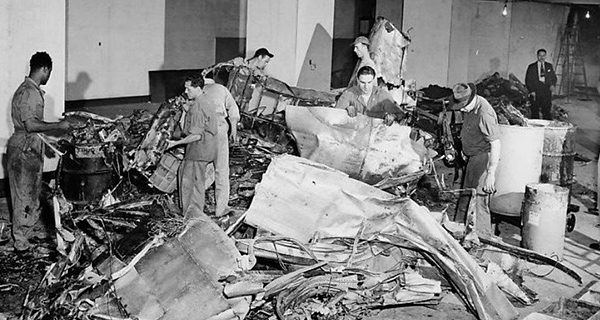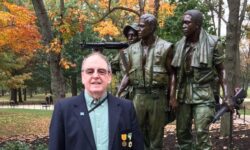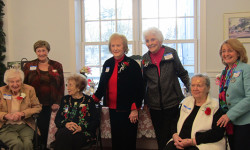[ccfic caption-text format="plaintext"]
By Bill Lombardi
Hometown Weekly Correspondent
July 28, 1945 is one birthday that I will never forget. I was spending my summer vacation with my aunt and uncle in the Bronx, New York. That morning, we got up early and went downtown. When we arrived, we heard the loud screeching of fire engines and ambulances. People were yelling: “Airplane crashed into the Empire State Building!” Everything was chaotic as we moved closer to the scene. Barricades were set up by the police to prevent onlookers from getting hurt and to keep them away from the crash.
I remember looking up and seeing smoke coming from near the top of the Empire State Building. Throughout my lifetime, I often wondered what really happened that day. I researched and found out.
The pilot was 27 year-old Lt. Colonel Bill Smith, a 1942 West Point graduate. He played varsity football and was an All-American in lacrosse. At the academy, he met and married army nurse Lt. Martha Molloy. When she was pregnant with their son, William Jr., Martha left the army and came home to live with her parents at 54 Beechwood Ave. in Watertown, MA.
World War II was being fought, and Bill wanted to be a flyer. When Martha agreed, he volunteered for the Air Corps, which is now known as the Air Force. Periodically, he would make arrangements to have flowers sent home to her. Smith flew many dangerous bombing missions over Germany and was highly decorated. Once, he was almost shot down by enemy planes, but a U.S. fighter came to his rescue and escorted his crippled bomber across the English Channel to safety.
In July of 1945, two months after Germany was defeated, Smith came home on leave. Martha and Bill slipped away for a few days at the Hotel Beaconsfield in Brookline to be alone. On the morning of July 28, after a farewell to his in-laws and baby son, Bill and Martha drove to Bedford Air Base, where he was to fly a B-25 “Billy Mitchell” bomber back to his new base in Sioux City, IA, with a stop-over in Newark, NJ. When they arrived, the B-25 was being checked over and gassed up.
Chris Domitrovich, an airplane mechanic, was also on this flight. Only five months before, Chris escaped from the Germans after being shot down over Holland. He was rescued by the Dutch underground after narrowly being captured by a German patrol.
Bill kissed Martha goodbye. As the plane was ready to take off, a Jeep came speeding down the runway. Albert Perna, a twenty year-old sailor who wanted to hitch a ride to Newark, jumped out waving his hands frantically. He told Smith that he had just been given emergency leave and was going home to be with his grieving parents, who had received word that his older brother was killed in action in the South Pacific. A kamikaze suicide plane landed and exploded on the deck of his ship. Smith told Perna to hop aboard.
Martha watched as the bomber, with the three men, took off down the runway and slowly lifted off. It was 8:55 a.m. She discovered that her husband still had the keys and radio operators tried to contact him to return, but were unable to do so. As the plane disappeared, Martha remembers having a strange and scary premonition that she would never see her husband alive again.
As the bomber flew over Connecticut, the weather pattern began to change, and so did the visibility. In and around New York City, there was a light drizzle and heavy fog. Planes were being guided by beacon signals and radio. Newark airport had been warning planes to beware of high buildings. Air traffic was very heavy. There was some confusion, because several planes scheduled to land were late. Others had to circle the field and wait for clearance.
Smith was informed he could land at nearby LaGuardia, but chose to wait to land at Newark. Bill started to descend slightly over the East River. He probably thought he was heading toward Jersey City and on to Newark. Instead, he was flying over Manhattan and heading directly toward the Empire State Building, which at the time was the tallest in the world with 102 floors.
The roar and loud noise of the engine of the B-25 attracted everyone’s attention on the street. They looked up to see where it was coming from. There was excitement and panic. People in the surrounding dwellings could see the bomber as it continued to fly down Fifth Avenue, at a dangerously low altitude. On the observation platform of the Empire Empire State Building, there were about a dozen sightseers who heard the deafening noise of the plane as it came closer and closer. Suddenly, it came down out of the clouds and fog into full view.
Smith must have been horrified as he frantically tried to gain altitude by pulling backward on the stick. With the nose now in a vertical position, the bomber slammed into the 78th and 79th floors, shaking the area like an earthquake. It was 9:55 a.m. A wing and other parts of the plane fell onto the street and the rest of the plane stuck right in the building. Three explosions were heard. Flaming gasoline spread through offices and corridors and down elevator shafts. Trapped victims screamed as they burnt to death.
Chunks of the plane landed on the ground for five blocks around. Incredibly, no one on the street was seriously hurt. Pieces fell on nearby roofs, setting them on fire. Normally, there would have been about 14,000 people in the building, but because it was Saturday, there was only a skeleton crew. The point of the greatest impact was at the offices of the National Catholic Welfare Conference on the 79th floor, where many of the deaths occurred.
The crash snapped the cables of three elevator cars that a plunged to the basement. Twenty year-old elevator operator Betty Lou Oliver was alone when a flash of fire passed through and scorched her face and hands. She tried desperately to stop it and screamed as it fell faster and faster. The elevator crashed against a buffer that went straight through the middle, missing her by inches. Donald Molony, as seventeen year-old Coast Guard hospital medic, ran into a drugstore and, after identifying himself, the pharmacist gave him first-aid equipment, including morphine. He ran to the basement, where firefighters were dousing the hot elevator with water. Molony crawled through the debris, heard Betty Lou crying, and lowered himself down. He found she had two steel beams across her body and was in great pain. After removing them, he injected her with morphine and then gently lifted her out. Miraculously, she survived; she suffered severe burns, back injuries and had both legs broken.
In all, fourteen people were killed. Many sustained lifetime injuries. For the Perna family, it was a double tragedy. They lost two sons. Martha never remarried. She became a school teacher in the suburbs outside Boston and lived into her mid-nineties. Her son, William, was a decorated war hero with the U.S. Marine Corps during the Vietnam War.
Today, the only trace of the disaster is black spot embedded in the northwest side of the building between the 78th and 79th floor. It was left there intentionally to commemorate the plane crash.
Bill Lombardi is a U.S. Marine Corps veteran. He is the grandfather of Emily, Ashley and Zachary Sullivan, and Cayce and Jimmy Lombardi - all Walpole residents.























